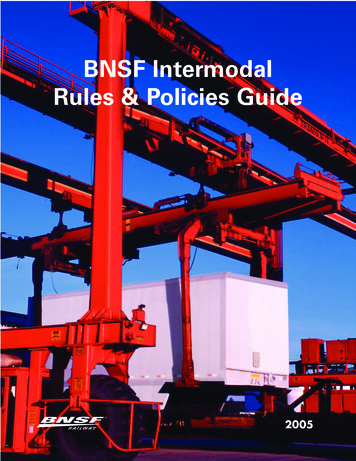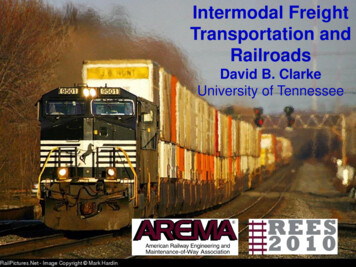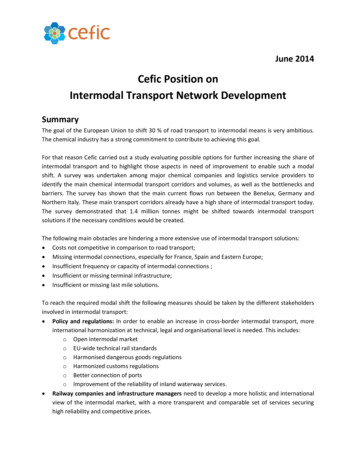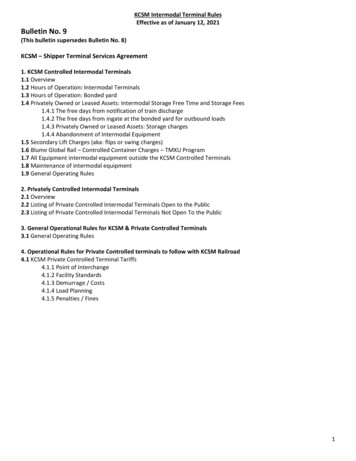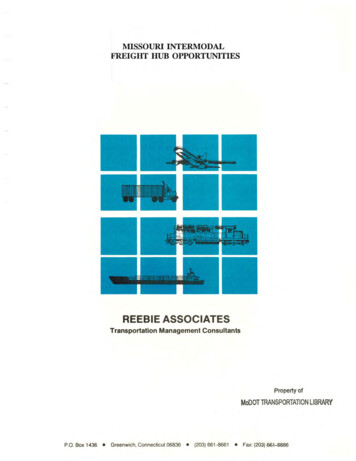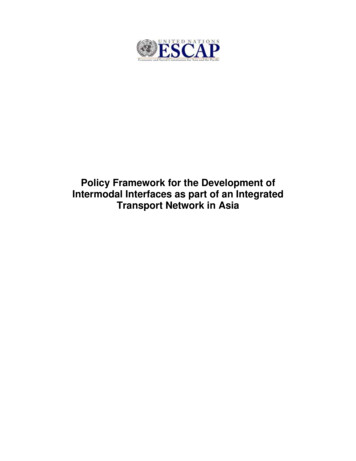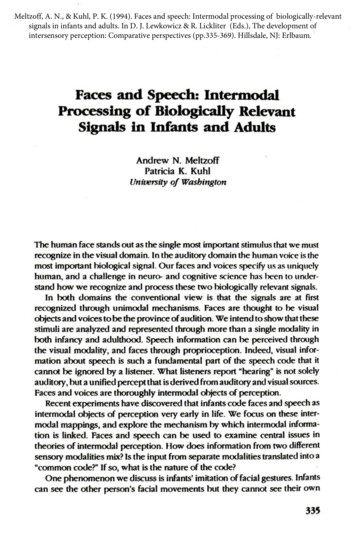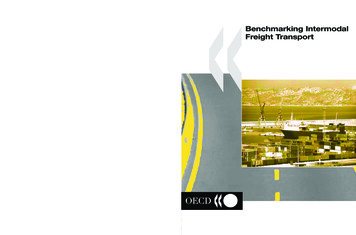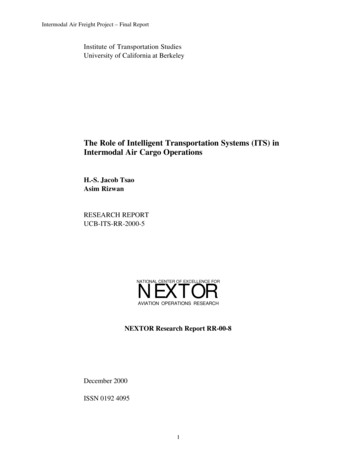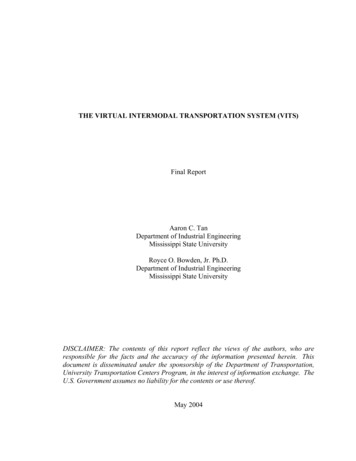
Transcription
THE VIRTUAL INTERMODAL TRANSPORTATION SYSTEM (VITS)Final ReportAaron C. TanDepartment of Industrial EngineeringMississippi State UniversityRoyce O. Bowden, Jr. Ph.D.Department of Industrial EngineeringMississippi State UniversityDISCLAIMER: The contents of this report reflect the views of the authors, who areresponsible for the facts and the accuracy of the information presented herein. Thisdocument is disseminated under the sponsorship of the Department of Transportation,University Transportation Centers Program, in the interest of information exchange. TheU.S. Government assumes no liability for the contents or use thereof.May 2004
Project AbstractAvailable tools are insufficient to provide the needed systemwide view forplanning freight transportation systems based on the coordinated use of more than onemode of transportation. Many tools are either mode specific or too microscopic in scope.No comprehensive tool exists that considers the performance of the entire system, whichis important due to the many interdependencies that exist between the different modes oftransportation. Optimizing a particular component of the transportation network couldresult in sub-optimization of the entire transportation system. Intermodal freighttransportation planning tools are needed to optimize future freight transportation systems.This study presents a prototype Virtual Intermodal Transportation System (VITS)that simulates the movement of freight via highways, railways, and waterways on astatewide level. The requirements as well as the processes for building the VITS areresearched and identified. Results from hypothetical case studies using the VITS are alsodiscussed.
TABLE OF CONTENTSPageDEDICATION. iiACKNOWLEDGEMENTS. iiiLIST OF TABLES. viiLIST OF FIGURES . ixCHAPTERI. INTRODUCTION .1.11Utility of a Virtual Intermodal Transportation Simulation System .2II. LITERATURE REVIEW .72.12.2Current Freight Transportation Studies/Agendas .Aspects in Freight Transportation Simulation .2.2.1 Transportation Science.2.2.2 Performance Measures.2.2.3 Port and Terminals.710101315III. VITS METHODOLOGY. 193.13.23.33.43.53.63.73.83.9Building of the Simulation Transportation Network .Vehicle Characteristics .3.2.1 Trucks .3.2.2 Ships and Barges.3.2.3 Rail.Vehicle Arrivals and Traffic Pattern.Routing of Vehicles .Transfers at Locations.Vehicle Speed Calculation.Simulation Animation and Graphics.Simulation OD Data Preparation .Performance Measures Implemented.3.9.1 Link Average Speed and Congestion.3.9.2 Fuel Efficiency.iii2331313232333742424950585859
CHAPTER3.10Page3.9.3 Zone Utilization of Highways.VITS Assumptions and Considerations .3.10.1 Truck Mode Assumptions.3.10.2 Rail Mode Assumptions.3.10.3 Water Mode Assumptions.3.10.4 Intermodal Assumptions .3.10.5 Fuel Consumption Assumption .60616263646565IV. VITS RESULTS . 664.14.24.3Scenarios for the VITS.4.1.1 Scenario 1: Base Condition.4.1.2 Scenario 2: Freight and Passenger Traffic VolumeDoubled for Each Mode of Transportation.4.1.3 Scenario 3: Increased Use of Intermodal Transportationfor Scenario 2.Validation.Conclusion for the VITS.666971738283V. ADDING MICROSCOPIC DETAILS: THE INTEGRATED PORT MODEL . 845.15.25.35.45.55.65.7Introduction. 84The VITS Integrated Port Model . 85Elements of the Port Model . 87Capacities for the Locations in the Port. 95Entity Attributes. 96Subroutines for the VITS Integrated Port Model. 975.6.1 Subroutine BerthTypeSUB() . 975.6.2 Subroutine BerthigSUB(CargoTypePAR, PortNo) . 985.6.3 Subroutine BerthOpHoursSUB(PortNo) . 995.6.4 Subroutine BerthLoadUnloadSUB(berthTypePAR, PortNo). 995.6.5 Subroutine DirectLU SUB(PortNo).1005.6.6 Subroutine PortLandsideLU SUB(PortNo) .1015.6.7 Subroutine TruckAccessGateSUB(PortNo).1015.6.8 Subroutine AccessGateHoursSUB(PortNo) .1015.6.9 Subroutine TruckResolutionSUB(Resoln, PortNo) .1025.6.10 Subroutine EntityCargoLUSUB(EntityType, CargoType,Luattrib, VesselType) .1025.6.11 Subroutine ProcLogicNoODSUB() .103Performance Measures for the Port.1035.7.1 Percentage Storage Used and Available Capacity .1045.7.2 Average Time Spent at the Port .1045.7.3 Port Tonnage Handled .105iv
CHAPTER5.8PageAssumptions of VITS Integrated Port Model .1065.8.1 Location for Arriving Vessels.1065.8.2 Queue Locations for Different Terminal Types.1075.8.3 Berth Locations.1075.8.4 Berth Loading/Unloading Processes.1075.8.5 Rail Processing Location .1075.8.6 Truck Processing Location .1085.8.7 Port Access Gate for Trucks .1085.8.8 Truck Waiting Location.108VI. INTEGRATED PORT MODEL RESULTS .1096.16.26.3Scenarios for the Port Model .1096.1.1 Scenario 1: The Integrated Port Model Within the VITSFramework .1096.1.2 Scenario 2: Increase in Freight Traffic .1116.1.3 Scenario 3: Improvements to the Port to HandleIncreased Traffic .112Validation.113VITS Integrated Port Model Conclusion .114VII. CONCLUSION AND FUTURE WORK .115VIII. REFERENCES .118v
LIST OF TABLESTABLEPage1.1Highlights of Transportation Related Software Packages . 63.1Color Code for Network Links . 253.2Speed Limits . 443.3Passenger Car Equivalents on Extended General Highway Segments. 473.4Color Coding for Truck Entity in the Simulation Model. 493.5Mississippi Ports Included in the VITS . 563.6Fuel Efficiencies . 594.1Summary of Results for Base Condition (Scenario 1) Simulation . 694.2Summary of Average Traveling Speed and Congestion Statisticsfor the Base Condition . 704.3Summary of Results for Scenario 2 Simulation (2X Increase). 724.3Summary of Average Traveling Speed and Congestion Statistics forScenario 2 (2X Increase) . 724.5Summary of Results for Scenario 3 Simulation (With Intermodal) . 764.6Summary of Average Traveling Speed and Congestion Statistics forScenario 3 (With Intermodal) . 774.7Overall Summary of the Four Scenarios. 804.8Summary of Results for Scenario 4 Simulation (With Intermodal) . 81vi
TABLEPage5.1Definition of Parameter Values . 995.2The Translation of Simulation Clock Hours. 996.1Results of Port Scenario 1 Using Base Condition Data.1106.2Results for Port Scenario 2 With Doubled Traffic Flow .1116.3Results for Port Scenario 3 With Increased Port Capacities.112vii
LIST OF FIGURESFIGUREPage3.1Animation Screenshot of the Prototype VITS Showing the Movements ofBarges, Trucks, Trains, and Ships over the Transportation Network. 203.2Relationship Between Major Components of the VITS . 213.3ArcView GIS with Data Views on Highways, Waterways, and Railways. 243.4All Highway Networks Used in Model . 273.5All State Highways and Interstates Used in the Model . 283.6All US Highways and Interstates Used in the Model . 293.7All Rail and Waterway Networks (Also Includes Interstates as Reference) . 303.8Plot of Link Traveling Speed (Light blue) and Congestion(Dark maroon) over Time (Hours). 373.9Example of the Storage of OD Routing Information in Excel. 393.10Illustration of the OD Subroutine Implementation . 403.11Interstate Speed-Flow Curve for α 0.45 and ß 7.5 . 443.12Screenshot of Vehicle Color Coding . 503.13 Traffic Analysis Zones in the Simulation Model (County MapGenerated Using TransCAD and Zones added Using a Graphics Editor). 533.14 Boundary Points and the Groupings Used for Simulation DataPreparation Assignment . 543.15Network Used for Critical Link Analysis in TransCAD . 57viii
FIGUREPage4.1The Selected Highway Links and the Direction of Flow forTraveling Speed, and Congestion. . 684.2Plot of Scenario 1 Traveling Speed (Light Blue) and Congestion(Dark Maroon) over Time (Hours) for Link R1 . 714.3Plot of Scenario 2 Traveling Speed (Light Blue) and Congestion(Dark Maroon) over Time (Hours) for Link R1 . 734.4Route Shift (Intermodal) for Future Scenario. 754.4Plot of Scenario 3 Traveling Speed (Light Blue) and Congestion(Dark Maroon) over Time (Hours) for Link R7.2 . 784.5Plot of Scenario 4 Traveling Speed (Light Blue) and Congestion(Dark Maroon) over Time (Hours) for Link R7.2 . 794.7Screenshots of the VITS Animations for Scenarios 1, 2, 3, and 4. 825.1Partial Screenshot of the Port of Gulfport Integrated PortSimulation Model. 925.2Flow Diagram of the Integrated Port Model. 935.2Animation Screenshot of the Port Model Showing theActivity Indicators .106ix
CHAPTER IINTRODUCTIONSince the advent of ISTEA (Intermodal Surface Transportation Efficiency Act of1991), and the more recent TEA-21 (Transportation Equity Act for the 21st Century),much effort has been garnered towards better understanding of intermodal systems andthe related system modeling issues. For example, Jones et. al. [1] offer a standarddefinition for intermodal transportation while Graham [2] in his thesis, “ModelingIntermodal Transportation Systems: Establishing a Common Language” lays thefoundation for the mathematical modeling of intermodal systems. Jones definesintermodal transportation as “the shipment of cargo and the movement of peopleinvolving more than one mode of transportation during a single, seamless journey”.Many research studies since then have identified a cause for concern in the futureof transportation in the United States. Using the southeastern states as an example, theever-increasing trade with neighboring Latin American countries as well as global tradecould overwhelm the transportation network in the near future. A study called “LATTS”(Latin America Trade and Transportation Study) goes into more detail on the existingtransportation infrastructure within the LATTS region and the impact of the freightincreases due to the LATTS traffic. This study postulates that the Latin American tradegatewaying through the Southeast Transportation Alliance is going to increase by 300%over the next 20 years [3].1
2It is certain that independent decisions made concerning these transportationissues, whether it is on statewide highway issues or capacity upgrades pertaining to acritical port in a particular region, may not account for the interactions that will occur inthe transportation system on a statewide level. Planning more comprehensively byconsidering the level of performance of the total system will require certain tools. Wewill call this tool the Virtual Intermodal Transportation System (VITS).The objective of this project is to research and develop the VITS to allow for alarge scale, systemwide examination of the freight transportation system withconsideration for all major modes of transportation and intermodalism. This research willaddress how discrete-event simulation technology can be used by transportation plannersto more effectively:oModel the random variation inherent in transportation systems as well as thecomplex interactions of how freight moves over the transportation network andthrough intermodal connector points.oEstimate how proposed localized changes will impact the performance of the overalltransportation system.oConduct statewide level analysis of systemwide design changes to the transportationinfrastructure and to effectively communicate the expected performance of thealternatives through powerful visualization/animation presentations.1.1Utility of a Virtual Intermodal Transportation Simulation SystemWhile many software tools that incorporate Geographic Information System(GIS) technologies and transportation planning tools help transportation planners
3evaluate their transportation network and the related infrastructures, there are deficienciesin most of these tools when it comes to statewide freight transportation planning. Forexample, a deterministic model for a port is sometimes used to calculate the averagethroughput and the practical capacity [3]. This deterministic model would treat truck flowinto the system as an average figure, with the flow spread out evenly over the entire day,and also the capacities of various resources as average figures based on some samples oftypical facilities in the region of study (as reported in the Louisiana Statewide IntermodalPlan study [5]). However, truck movement varies according to the time of day, thuscreating high-traffic periods and less-traffic periods, called temporal flow patterns. Aparticular link in the network (e.g. a highway link) may experience more or less vehicularflow/congestion than typically encountered within periods. This is called within-periodtemporal flow variation [6]. Temporal highway flow patterns can have a significant effecton the ability of a port to process freight from its facility. A simulation model such as theVITS, accounting for this stochasticity, can bring attention to unanticipated problemsarising from changes to policy and/or infrastructures that are not apparent when studyingaverage figures.Secondly, many transportation planning packages, although some contain asimulation component, lack the capability to effectively analyze means of transportationother than highway systems. In other cases, they are focusing only on some particularhighway corridors, and/or arterials for a localized study. In most cases, either the networkinformation for waterways and railways are not readily available, or the software simplydoes not handle these modes or capabilities to do mode transfers unless some extensive
4programming is done. The facilities that are key in intermodal transportation such asports and transfer terminals are often excluded from traffic analysis software. Theseshortfalls limit the ability for a comprehensive statewide freight transportation analysiswith consideration for intermodalism.For example, a study conducted by the Texas Public Policy Foundation on freightrail issues revealed that decisions concerning rail freight service could affect the numberof trucks operating on highways to a significant degree. The author of the report statesthat policies that encourage the expansion of commuter rail or inter-city rail service do soat the expense of rail freight service. This can effectively increase truck traffic, whichmight cause a disproportionate burden on the urban roadway system that is both difficultand expensive to expand [7]. This clearly demonstrates the interaction/relationshipbetween rail and truck modes that should be represented in decision support tools.The issue of microscopic versus macroscopic level of detail in the simulation isconsidered within the context of traffic flow. Adolf May, in his widely recognized bookin transportation engineering, “Traffic Flow Fundamentals”, explains that microscopicflow is one where the “time headway between vehicles” is of concern because of safety,level of service, driver behavior, and capacity issues in the transportation system (timeheadway is the temporal space between two vehicles). He defines macroscopic flow asone where the flow rate (or volume, expressed as an hourly rate) is the most importantcharacteristic [6]. Ramachandran explains that a microscopic analysis would beappropriate when there is a need to observe the behavior of individual units such as theacceleration and deceleration of truck entities, and a macroscopic analysis to be chosen
5when a higher density, large-scale system is to be analyzed (with the behavior of groupunits being adequate) [8]. Seneviratne states that, “macroscopic simulation models aredesigned to evaluate levels of service or congestion under stochastic dwell times anddemand conditions at selected locations or sections of the network”, whereas inmicroscopic simulation, “each vehicle is generated and tracked as an individual objectmoving through the system”. He further explains that at both levels of simulation, vehiclearrival rates, vehicle mix, and dwell times are parameters that can be varied over time toreflect stochasticity [9].The Virtual Intermodal Transportation System (VITS) would contain elements ofboth macroscopic and microscopic simulation. The statewide transportation networkportion would form the macroscopic portion, while the terminals and ports will form themicroscopic portion. The critical element is the interface between the microscopic part ofthe simulation and the macroscopic part of the simulation. Entity speed on thetransportation network for example, would be calculated based on the macroscopicparameters of flow rate and capacity, while the throughput of the port in terms ofcontainers processed, would be dependant upon the arrival times of individual vehicles,among other factors.Table 1.1 shows examples of some transportation software packages. It isimportant to recognize that none of these software packages are multimodal by design.Furthermore, most simulation packages are not designed to handle macroscopicsimulation.
6Table 1.1 Highlights of Transportation Related Software YesHighwayMultiRail FEYesYesRail onlyYesCORSIMNoYesHighway onlyNoSimTrafficNoYesHighway onlyNoVISSIMNoYesHighway onlyNoINTEGRATIONCustom*YesHighway onlyNoMETACORNoYesHighway onlyYes* The GIS functionality is available with additional programming by the userProduct NameGISComponentSimulationThere are numerous researches and knowledge on port simulations [10], highwayssimulation models [8], intermodal terminal issues [11], traffic flow [12][13],transportation performance measures [14][15], commodity flow studies and tripgeneration [16], and also vehicle routing models [17]. What is lacking is a concertedresearch effort to combine the fragmented research results into the building of a statewideintermodal freight transportation simulation model. This report will discuss the process ofresearch and development of a VITS prototype, present the results, and identifyimprovements to the prototype methodology. A port model template is included in thesimulation model to demonstrate the VITS’s ability to simulate both microscopic (port)and macroscopic details for improved decision support. We will also address some of theimportant issues that allow the building of a practical and credible intermodal freighttransportation simulation model. The prototype VITS model will use the State ofMississippi as an example.
CHAPTER IILITERATURE REVIEW2.1Current Freight Transportation Studies/AgendasThis section reviews the current freight transportation issues with the emphasis ondescribing future needs as well as the planning process in anticipation of significantfuture freight increases.The Latin America Trade and Transportation Study (LATTS) [3] was conductedby the Wilber Smith Associates to determine Latin American trade opportunities, as wellas to identify the transportation investments that are necessary to sustain trade growth.The alliance of states impacted by the Latin American trade in this study include Texas,Arkansas, Louisiana, Mississippi, Tennessee, Alabama, Georgia, Kentucky, Wyoming,Virginia, North Carolina, South Carolina, and Florida, which are referred to as “theAlliance” [3]. Studies such as these show the increasing concern about futuretransportation needs and the need for the evaluation of current transportation capacities toestimate investment costs in anticipation of future congestion.In order to conduct the analysis, “Port Terminal Planning Modules” weredeveloped for the Alliance states. Described in the Appendix IV of the LATTS report,these modules are used to quantify the throughput/capacity of the ports [3]. With themacro-level characteristics commonly tied to statewide freight transportation planning,these modules can form a good foundation for modeling purposes, especially for a7
8simulation model where specific parameters can be tweaked to match a particular portinstead of generalized regional characteristics. These simplified models of terminals canbenefit from including the stochastic nature of the system (such as weather conditions,equipment failures, etc.) as well as interaction between resources (e.g. slowdown ofberthing resources will certainly affect the throughput of the storage area and alsoinfluences the availability of related resources such as conveyors and forklifts),increasing their analytical sportationInfrastructure Plan) study [18] is a statewide transportation study that was initiated by theMississippi Department of Transportation (MDOT) to conduct a comprehensive analysisof transportation infrastructure and needs throughout the state. However, the statisticsthat are reported on highways include Vehicle Miles Traveled (VMT), Average DailyTraffic, and Volume-Service Flow Ratio. These statistics are being used for comparisonacross states, but being either cumulative figures or average figures, they cannot provideany details on problematic spikes in traffic that can occur. A particular section of interestis the identification of the Statewide Transportation Framework as an integral componentof the MULTIPLAN study. This framework serves to evaluate the transportation networkas it currently exists, and can be used to forecast the system’s future performance [18].Inclusive of all significant highways, railroads, waterways, and airports, this networkwould be a logical choice when determining the level of detail required for atransportation simulation network of the state of Mississippi. However, some additionalwork may be required to adapt this network for freight transportation simulation.
9The State of Virginia has been involved in developing a methodology forstatewide freight transportation planning. In this study [16], an advisory committee ofpublic and private stakeholders in freight transportation was formed (FAC). There was nomention of any use of simulation models in the Virginia study. The FAC could certainlyuse simulation as a tool to help them evaluate alternatives and to quantify theperformance measures.Examining the Louisiana statewide intermodal plan, their report by the NationalPorts and Waterways Institute of the Louisiana State University submitted in July 1995[5] emphasized rail, ports, waterways, and intermodal connections between these modesof transportation. The study focuses on developing measures of capacity of the uniquetransshipment facilities at marine and rail-highway terminals throughout the state.Definitions and categorization of intermodal freight terminals were done and capacityanalysis included five generic types of terminals with four involved in water-landtransfers and one in land-land transfers. These ideas can certainly benefit thedevelopment of the port simulation model by providing an example framework as well asstatistics that are typically used to determine capacities. Based on studies such as theexamination of Mississippi Industrial Gulf Ports by Couvillion and Allen, informationsuch as commodities handled, berth configurations, storage areas, and cranes availablecan be obtained for the initial process of model building [19].The Louisiana research team devised an approach called “Stock & Flow” (orsimply S&F) that is based on the analysis of terminal operations and the related facilities.To do this, the terminal facilities are categorized as Flow Processing Components (trains,
10trucks, cranes. etc.) or as Stock Holding Components (storage facilities). This approachhas three steps where the terminal is represented as a schematic network of S&Fcomponent
much effort has been garnered towards better understanding of intermodal systems and the related system modeling issues. For example, Jones et. al. [1] offer a standard definition for intermodal transportation while Graham [2] in his thesis, "Modeling Intermodal Transportation Systems: Establishing a Common Language" lays the


